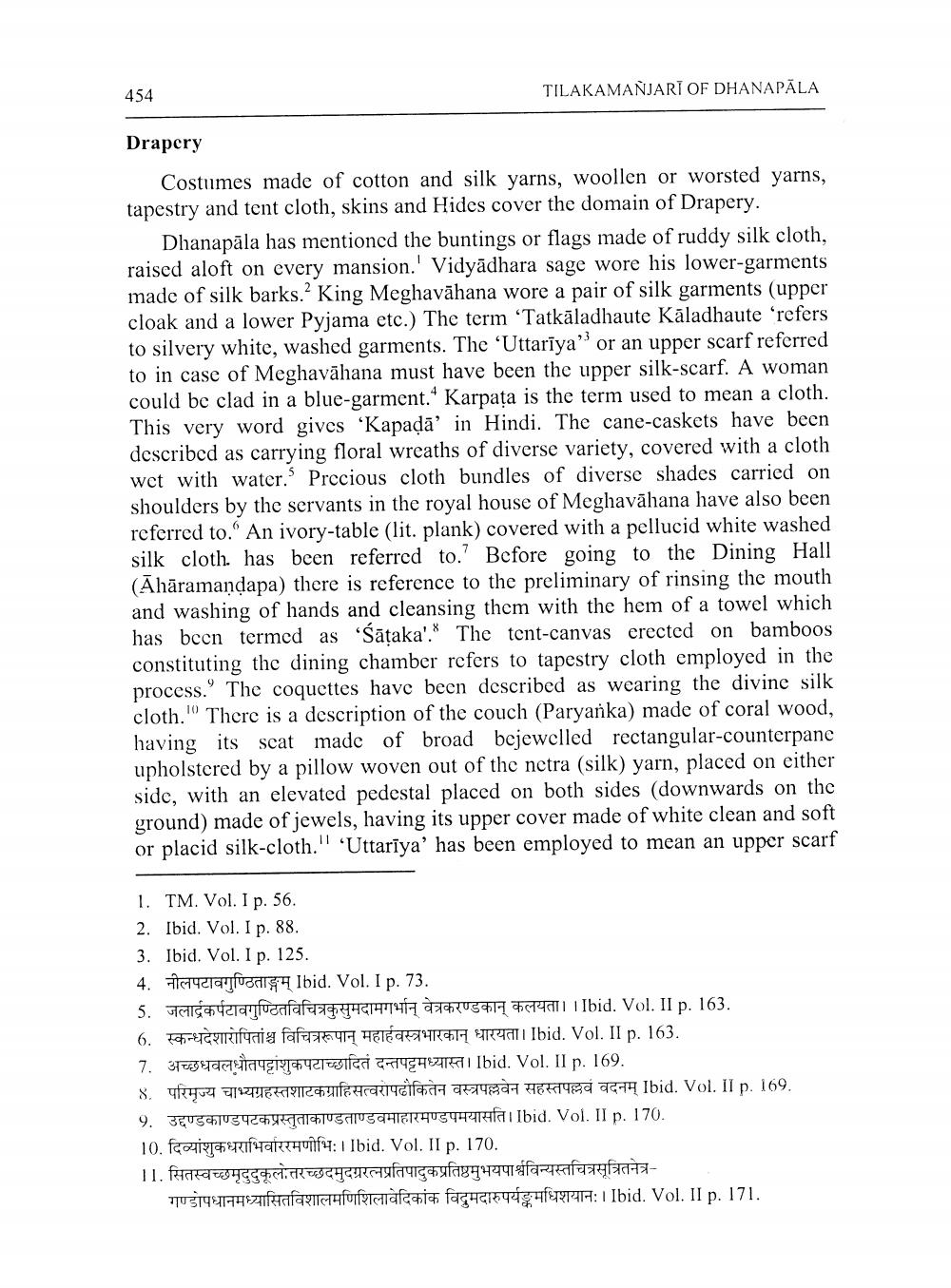________________
454
TILAKAMANJARĪ OF DHANAPALA
Drapery
Costumes made of cotton and silk yarns, woollen or worsted yarns, tapestry and tent cloth, skins and Hides cover the domain of Drapery.
Dhanapāla has mentioned the buntings or flags made of ruddy silk cloth, raised aloft on every mansion. Vidyādhara sage wore his lower-garments made of silk barks. King Meghavāhana wore a pair of silk garments (upper cloak and a lower Pyjama etc.) The term “Tatkāladhaute Kāladhaute 'refers to silvery white, washed garments. The 'Uttariya” or an upper scarf referred to in case of Meghavāhana must have been the upper silk-scarf. A woman could be clad in a blue-garment.* Karpața is the term used to mean a cloth. This very word gives ‘Kapadā' in Hindi. The cane-caskets have been described as carrying floral wreaths of diverse variety, covered with a cloth wet with water. Precious cloth bundles of diverse shades carried on shoulders by the servants in the royal house of Meghavāhana have also been referred to.' An ivory-table (lit. plank) covered with a pellucid white washed silk cloth. has been referred to. Before going to the Dining Hall (Ahāramandapa) there is reference to the preliminary of rinsing the mouth and washing of hands and cleansing them with the hem of a towel which has been termed as 'Śāțaka'. The tent-canvas erected on bamboos constituting the dining chamber refers to tapestry cloth employed in the process. The coquettes have been described as wearing the divine silk cloth." There is a description of the couch (Paryanka) made of coral wood, having its scat made of broad bejewelled rectangular-counterpane upholstered by a pillow woven out of the netra (silk) yarn, placed on either side, with an elevated pedestal placed on both sides (downwards on the ground) made of jewels, having its upper cover made of white clean and soft or placid silk-cloth." 'Uttarīya' has been employed to mean an upper scarf
1. TM. Vol. I p. 56. 2. Ibid. Vol. I p. 88. 3. Ibid. Vol. I p. 125. 4. 1742 aufuonis Ibid. Vol. I p. 73. 5. Gazanfuegraf477 146147477 U5411 octeau i Ibid. Vol. II p. 163. 6. EGYRI Ni a fafes & T reat Ibid. Vol. II p. 163. 7. 3173ECTAYET?]+421 145HEZITI Ibid. Vol. II p. 169. 8. ufqug 1799|| E HORTY Cifah 277494 Tata 2674 Ibid. Vol. II p. 169. 9. SEVSAY209 alcuSSISCHERAUST I Ibid. Vol. II p. 170. 10. fli Ferrarchuif: 1 Ibid. Vol. II p. 170. 11. सितस्वच्छमृदुदुकूलोत्तरच्छदमुदग्ररत्नप्रतिपादुकप्रतिष्ठमुभयपार्श्वविन्यस्तचित्रसूत्रितनेत्र
TTSTY9919 rafagicTefufricàcich faghai HERTH: 1 Ibid. Vol. II p. 171.




